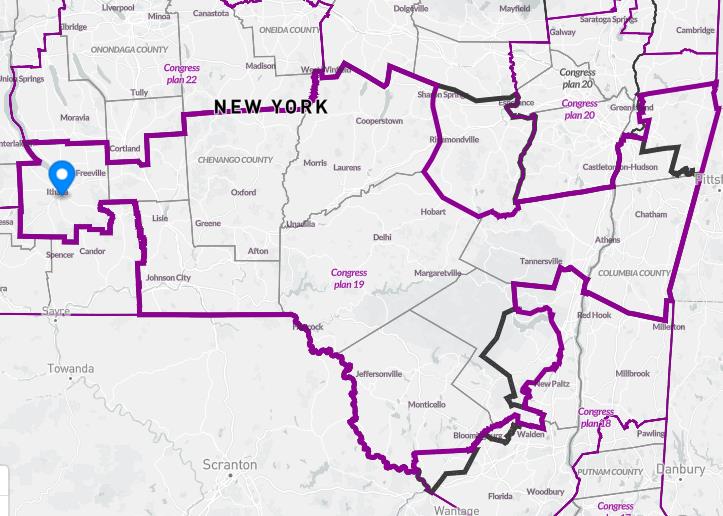
by Robert Lynch; February 27, 2024; latest update, February 29, 2024
With fast legislative action, and with Governor Kathy Hochul’s quick concurrence, Albany lawmakers Wednesday put a likely legislative end to the task of redistricting Congressional seats for this November and for the remainder of the decade. And it appears ever more likely that Republicans will simply let matters stand.
By a vote of 45 to 17 in the State Senate and 115 to 33 in the Assembly, the Legislature, given the power of its Democratic supermajorities, ratified the redrawn district lines unveiled just one day earlier. The new maps’ release followed Monday’s rejection by legislators of the compromise maps submitted February 15th by the bipartisan Independent Redistricting Commission.
Governor Hochul gave the revised maps her approval late Wednesday, but provided no press release on her official website to explain her support.
Meanwhile, according to one Republican point-person in the redistricting debate, the GOP will not repeat its successful 2022 attempt to contest the legislative maps in court.
“No challenge,” former New York Representative John Faso, a key player in the 2022 GOP-led litigation, wrote in a text message Wednesday to The Hill, a Congressionally-focused news site. “These maps are not materially different from those prepared by the special master as a result of our court victory against the [Democratic] gerrymander,” Faso texted.
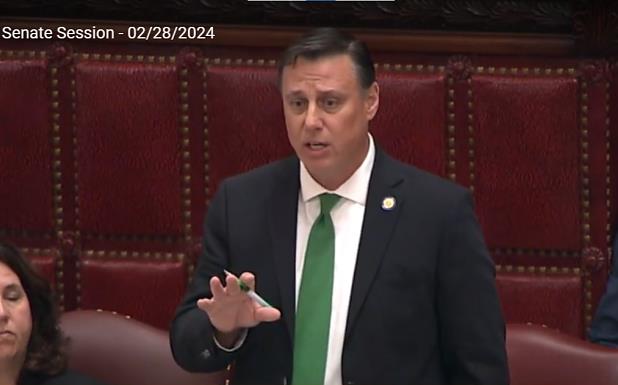
Final Senate and Assembly action Wednesday paled by comparison to the Republican ruckus raised Monday when Democrats voted down the Independent Redistricting Commission’s (IRC) submission. Indeed, three Republican Senators; Bill Weber of Rockland County Alexis Weik of Long Island, and Mark Walczyk of the Watertown area, failed to join other Republicans in their opposition. About a dozen Assembly Republicans also crossed over to support the new maps.
“The voters chose a commission to make this decision. That’s not what we have here,” Suffolk County Republican Senator Anthony Palumbo said in a final foray to stop his upper house’s adoption of the Democrat-engineered adjustments approved Wednesday. “For these reasons, I’ll be voting no.”
A couple of Republicans in the Assembly were equally vocal before their final vote.
“It could look to the residents of New York State that we took 10-15 million dollars of residents’ money, put it into the IRC, put it into redistricting, thumbed our nose at them, and said no, no, no… it doesn’t matter that we went through the whole process, we just don’t like what they came up with, so we’ll make up our own,” Long Island Assemblymember Michael Durso chided Democrats.
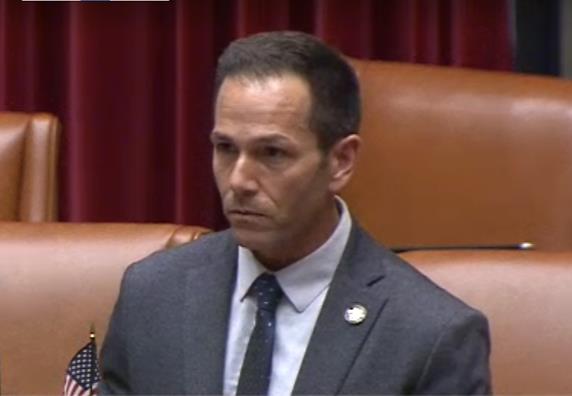
Final debate in the Assembly consumed only about a half-hour Wednesday. Senators took slightly less time than that. Senator Andrew Lanza tried in vain to pin down Deputy Majority Leader Michael Gianaris on how long the Democrats had kept the revised districting on their hard drives or on paper before releasing them Tuesday. He also had no luck questioning Gianaris on whether Congressional Minority Leader Hakeem Jeffries had played a role in the process.
Gianaris insisted the new maps did not exist before majority Democrats rejected the IRC’s maps Monday.
As for leader Jeffries, The New York Times Wednesday quoted the New York City Congressional leader as commending the latest districting adjustments.
“This is a much fairer map for the people of the state of New York,” Jeffries told The Times prior to the State Legislature’s vote. “This is a much fairer map for the people of the State of New York,”
[The Original story, filed February 27th, upon the legislative maps’ release, follows]
****
Face it, being a little bit gerrymandered is akin to being a little bit pregnant. And if that’s the case, the “tinkering” New York legislative Democrats have done to commission-drawn Congressional redistricting, maps these final days of February is no better than had they thrown those commission maps into the trash and started afresh—just like they tried to do two years ago.
But that’s the purist way of thinking. Political pragmatism may tell us something else again.
Tuesday afternoon, one day after Democrats in the State Senate and Assembly wielded their super-majority muscle to reject the compromise Congressional redistricting maps released February 15th by the state’s Independent Redistricting Commission (IRC), legislative Democrats released maps of their own.
As one of their key changes, the legislative maps would alter the geographical composition of the 19th Congressional District, yet continue to retain Tompkins County within it. Most changes to NY-19 would be at the district’s eastern end, purportedly engineered to give Republican incumbent Marc Molinaro a trougher time in seeking reelection.
As drawn by both the IRC and legislative Democrats, the 19th District would continue to stretch from the Town of Enfield’s western border east, through Binghamton, to the Massachusetts state line.
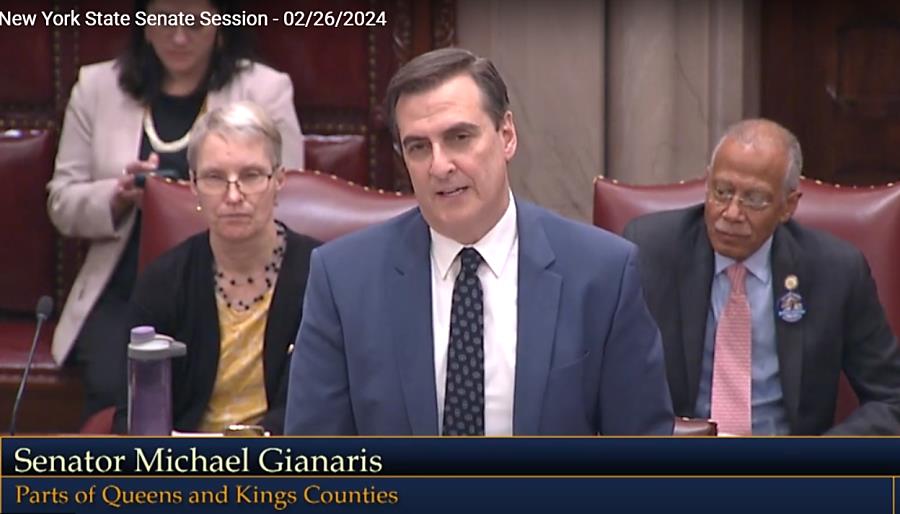
“I think there are numerous problems with the maps that were sent to us that run afoul of the constitutional guidelines that exist in our state constitution,” Senator Michael Gianaris, Deputy Majority Leader and the Democrats’ unquestioned point-person in opposition to the IRC maps, said during floor debate Monday. “The maps should not be drawn specifically to protect incumbents,” Gianaris asserted. “It was clear that the intention of the map is simply to protect incumbents of both parties.”
Arguably, Gianaris had a point about incumbent protection. (And some argue the IRC specifically sought to protect Molinaro.) But in truth, were his handful of grievances sufficient and blatant enough to warrant legislators derailing a carefully-crafted process designed to remove redistricting from partisan pressure, an effort enshrined in a decade-old amendment to the New York Constitution? The Deputy Majority leader believes they are. Minority Republicans maintain they were not.
“You can sit here and point out what you don’t like about these maps, but this is the process that the people of New York State chose,” Senator George Borello, a Republican from the western Southern Tier, fired back during the debate.
“Because the reality is we don’t really care what the people think; we care what the political outcome is in the end, and that’s what this is about” Borello, a Republican, portrayed as Democrats’ view of the electorate.
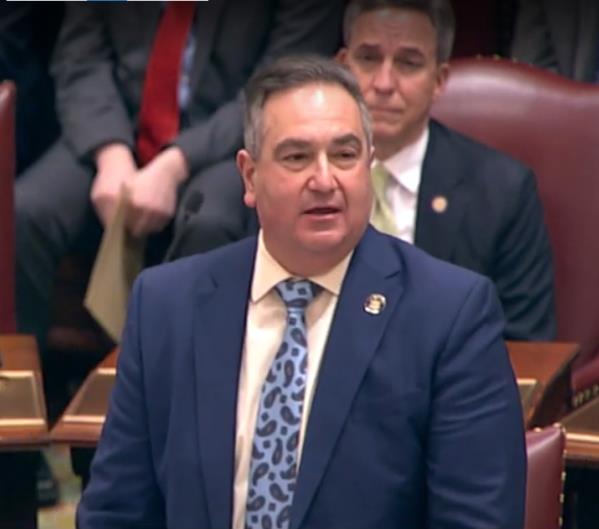
“We are once again going to undermine this process, to say we don’t trust you, the people that brought us here, the people that vote for us,” Borello continued, “We don’t trust you to do the right thing. We’re going to tell you what your will is. That’s wrong. That’s why I am supporting these maps.”
Only through self-professed “cooperation and compromise.”—read into that political horse-trading—were most of the ten members of the Independent redistricting Commission able to agree on the compromise Congressional maps they handed up two weeks ago. The IRC was (and is) evenly divided between the parties. The IRC’s this year’s submission won the approval from nine of its members. Commission chair Ken Jenkins said at the time that members worked cooperatively and collaboratively to resolve their disagreements.
Yet still, anything that breathes a wisp of bipartisanship falls short of satisfying partisan Democrats who hold firm control of both Senate and Assembly. Monday, each house voted down the IRC’s maps on largely party-line votes.
The State Senate rejected the IRC maps, 40 votes to 17. The Assembly then similarly voted them down, 99 votes to 47. State Senator Lea Webb and Assemblymember Anna Kelles, both Democrats voted with their majority party.
Upstate, the Democrats’ drafting efforts clearly have twin goals, both of them partisan and both lying close to home: First, Democrats want to ease the path for their party’s presumptive Congressional nominee, Josh Riley, in his effort to oust NY-19 incumbent Molinaro. And secondly, they seek to preserve the IRC’s adjustment in the Syracuse-based 22nd Congressional District and thwart the re-election bid of another, one-term GOP incumbent, Brandon Williams.
The Independent Redistricting Commission proposed—and legislative Democrats would continue—the shift of the cities of Cortland and Auburn into Williams’ 22nd District. The migration of Cortland to NY-22 cuts Cortland County in half. And the retention of Cortland County’s southern towns within the 19th District is all that connects Tompkins County to the rest of the 19th’s sprawling geography.
To look at it, Tompkins County sticks out like a sore thumb. But of course, legislative Democrats count on Tompkins County’s overwhelming liberal base to counter-weight the 19th District’s otherwise red tinge in their efforts to oust Republican Molinaro.
Torpedoing the IRC’s Congressional maps wasn’t the only matter the State Senate took up Monday. In fact, it spent a much longer share of its session debating a procedural bill that would make it much harder for Republicans to pick a favorite court should they choose to challenge the Democrats’ maps similar to what they did two years ago.
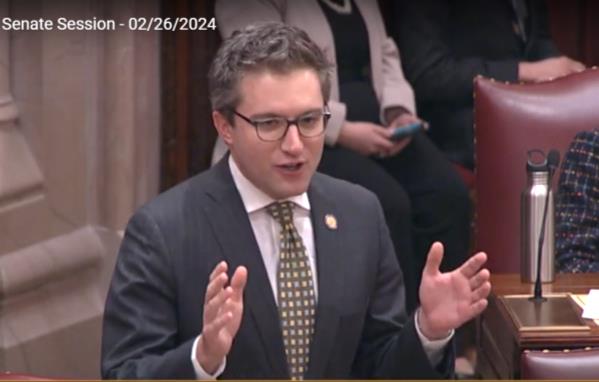
By another party-line vote of 39 to 18, the Senate approved a bill that would limit redistricting challenges to just four State Supreme Court venues in the state; courts in Albany, Buffalo, Westchester County and Manhattan. Not coincidentally, most of the judges in those four venues are fellow-Democrats.
When GOP petitioners launched a successful challenge to Democratic-gerrymandered Congressional maps in 2022, they chose a Republican state judge in Steuben County who threw out what Democrats had attempted and appointed a special master to draw district lines to where they currently stand. The New York Court of Appeals allowed those lines to stand for just one election cycle, but the lesson was never lost that where you find a judge can dictate your lawsuit’s outcome.
“What happens is that party officials, they reverse-engineer these things and they look for a plaintiff” after they pick the judge, Senator James Skoufis, a Democrat, said in support of confining redistricting venue to specific courts. “If we’re being honest here, if we’re being transparent, we all know in this chamber how these lawsuits work.”
Republican James Tedisco took the opposite view. The Saratoga County lawmaker said it’s all about exploiting partisan control.
“It seems that a supermajority isn’t good enough for you, Tedisco chided Democrats. “This is the ultimate… judiciary and judge and court shopping,” he said, since plaintiffs under the majority’s scheme could only file suit where Democrats sit on the bench. “There’s a variety of things you can do to win elections. To cheat with our judiciary is not one of the better things, I think.”
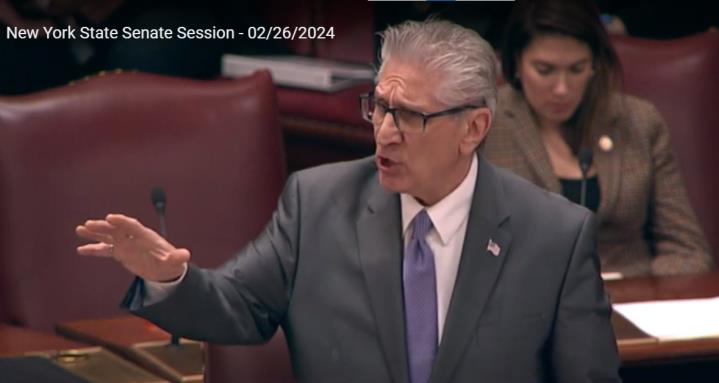
Prior to Monday’s rejection of the IRC’s maps and Tuesday’s substitute etchings of their own, Democrats in the know had promised “tinkering” with the Commission’s proposal, but few had predicted any full-frontal attack as was attempted two years ago by the Legislature, a gerrymandering attempt that only the Court of Appeals thwarted.
Now that the dust is settling, some within the party of FDR express disappointment that their fellow party members in Albany had not proven more aggressive this week.
“It’s hard not to look at these proposed maps and think, what was the point of all this?” Evan Roth Smith, a Democratic consultant who works on House races in New York told The New York Times Tuesday.
Roth Smith cited states where Republicans wield the gerrymander pen more shamelessly. “When we find ourselves in the same position, we wuss out… It’s a shame,” Roth Smith told the paper.
Aside from preserving the IRC’s bluer hue to the Syracuse-based Brandon Williams district and enhancing Josh Riley’s prospects for beating Molinaro, legislative Democrats tinkered with a few districts on Long Island, most notably making it easier for newly-elected Congressman Tom Suozzi, the disgraced George Santos’ successor, to retain his seat for Democrats this November. Media reports say some in other downstate districts view the Legislature’s cautious approach as opportunity lost.
With Suozzi’s recent election, New York now sends 16 Democrats and 10 Republicans to Congress. Political handicappers predict the outcome of Tuesday’s tinkering could produce 18 safe Democratic seats, six similarly safe for Republicans, and two races too close to call.
“The map may be imperfect for Democrats, but it does give them a decent foundation to win back the House,” former downstate Congressman Steve Israel, a key Democratic operative, told The Times.
Another observer viewed what Democrats had done as a “mild/moderate gerrymander.”
Indeed, though it’s too soon to tell, the limited reach legislative Democrats have now taken could stave off any Republican-initiated lawsuit this year, unlike in 2022.
Dryden Democrat Mike Lane, commenting on the floor of the Tompkins County Legislature February 20th, one week before Albany lawmakers put these latest revisions on the table, called the IRC’s boundaries for the 19th District “the most ridiculous” of any in New York State. He faulted the IRC for connecting Tompkins County to the district’s remainder by only “a small neck” of land.
Yet Lane will undoubtedly find little solace in the most recent adjustments his own party has just made. The “small neck” remains. The district’s gerrymandered shape proves evident.
“The redistricting games that are played; I don’t care which state, which party; they’re not a good thing,” Mike Lane said to the County Legislature that night. “I think Tompkins County got mistreated again in this redistricting process,” he complained.
But on the floor of the State Senate six days later, Republican Jack Martins put his trust in that ten-member bipartisan commission that he said did the right thing, even if lines should occasionally veer helter-skelter.
“These lines aren’t drawn haphazardly,” Martins asserted. “You don’t have ten people just sitting around a table with magic markers and pens trying to draw these maps. These maps are drawn meticulously. They’re drawn in conformance with law. They’re drawn with all the best intentions.”
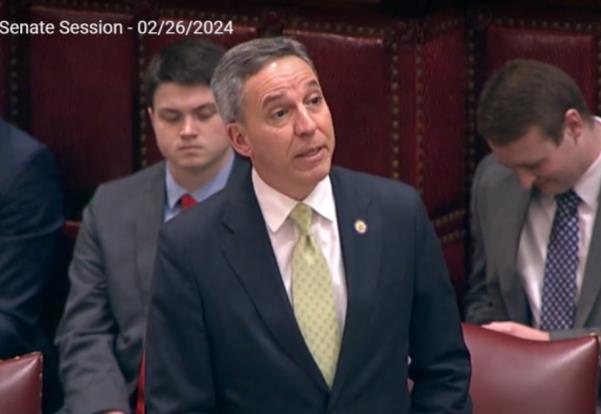
But the lines have been altered, nonetheless, and at Democrats’ insistence. And it’s occurred even though the impact here in Tompkins County will prove minimal. The Democrats’ lines and the IRC’s lines remain the same for us. Even should a GOP court challenge succeed, we’d still have Marc Molinaro as our Congressman, and Josh Riley would most likely be his November opponent. Those NY-22 district lines to our northeast will probably remain the same as well.
One tantalizing tidbit has emerged amidst the media buzz concerning redistricting as it impacts our own 19th District. Nicholas Fandos of the New York Times, working his sources, reported Tuesday that Josh Riley had flirted with giving up on running against Molinaro and considered competing in the more blue-friendly redrawn 22nd District instead, had the IRC’s draft maps been accepted without change.
Having run and lost in the 19th two years ago and having raised tons of cash for a Molinaro rematch since then, Riley’s exodus would have surprised and disappointed many diehard Democrats. But if district lines hold—as it appears ever-more-likely they will—Riley’s prospective move north now appears as a back-up plan never in need of execution.
A little bit of gerrymandering is sometimes all that’s needed.
###

